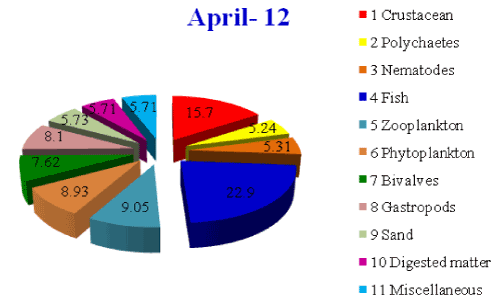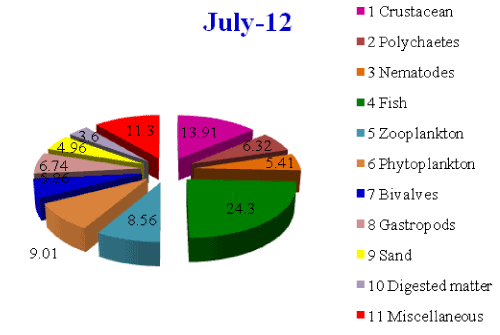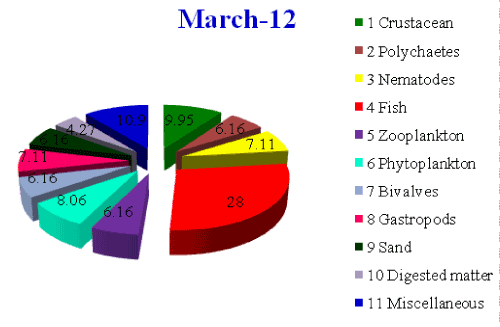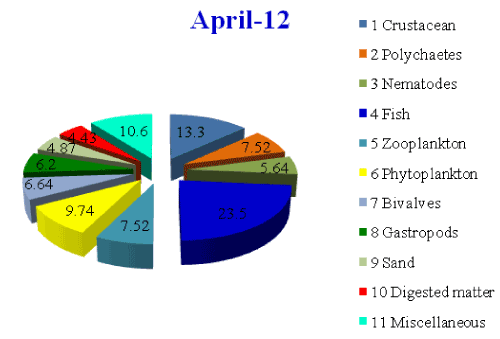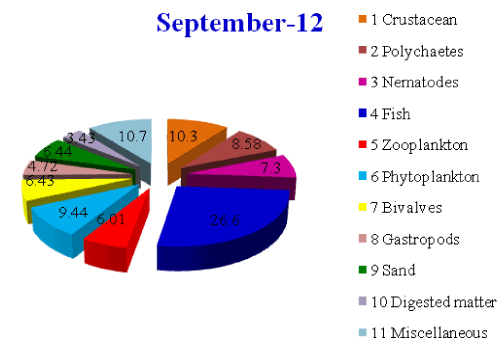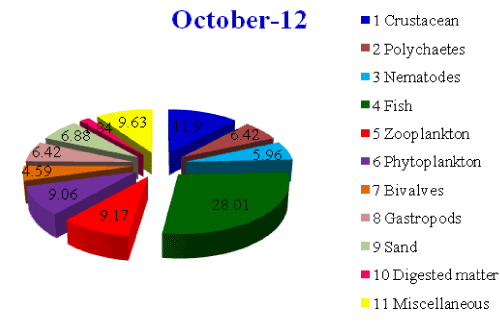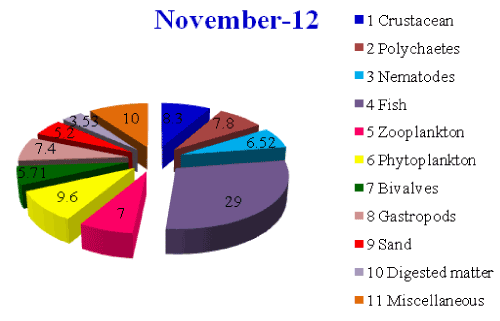| Keywords |
| Pterois; Russell’s lionfish; Stomach content; Feed composition; Aquarium fish |
| Introduction |
| A study of the food and feeding habits of fishes are important in the life sciences research. The feeding habits, it is one of the main activities of everyday living in fishes. The stomach content analysis is widely used the fish ecology and as important of tropic relationship of fishes. And are good understanding of fish life stages especially growth, migration, spawning, healthy and survival. Food is important for fishes, since it will contain all the nutrients and there were maintain a whole body function is correctly. The knowledge on the food and feeding habits is mainly important for understanding the fish biology and spawning stimulations. Food and feeding habits of different fishes have been studied different workers viz.,Nieland [1] have studied in Sardinella aurita (Val.) and Sardinella eba (Val.) off the coast of Senegal. Dadzie [2] have studied in silver pomfret, Pampus argenteus (Euphrasen), in Kuwait waters. Rao [3] have studied in Glossogobius giuris from Gosthani Estuary, Olojo [4] have studied in Synodontis nigrita from the Nigeria, Mohammed [5] have studied in Sillago sihama (Forskal) from Iraqi Marine Waters, Serajuddin [6] have studied in Syriped Spiny Eel, Macrognathus pancalus (Hamilton). Tsiklirasi [7] have studied in round Sardinella (Sardinella aurita) in the northeastern Mediterranean (Aegean Sea, Greece). Oronsaye [8] have studied in Chrysichthys nigrodigitatus and Brycinus nurse in a tropical river. Abdel- Aziz [9] has studied in round Sardinella (Sardinella aurita) in El-Mex Bay, Alexandria. The analysis of the gut content provides necessary information regarding their feed preference in the wild and this will be helpful in establishing a diet for faster growth and reproduction in the culture systems. The relationship between fish and food organism is essential for the production and exploitation of the fish stocks. This relationship has been used for the fishery exploited the diversity of the species in a particular region of total fishery. The Russell’s Lionfish P. russelii is a vital source of food for people and are significantly benefit of social and economic importance. The hobbies of the most of the people are to keep P. russelii in the aquarium. Maintenance of healthy aquarium and proper feeding is essential and it is a main role of a culturing system. The study of food and feeding habits of Russell’s Lionfish will helps in mass scale culture and this in turn helps in conservation of this exotic fish. Hence, the present study has been undertaken to gather information concerning the food and feeding habits of P. russelii. |
| Materials and Methods |
| By using Trawl nets the specimens were collected randomly at Cuddalore coast (11°42'N, 74°46'E), during between January 2012 and December 2012. After collection, the fish P. russelii were stored in ice boxes and the stomach were removed and fixed in 10% buffered formalin. The stomach contents of male and females were later analyzed in the laboratory. Immediately after the collection the standard length of the fish was recorded before removing the gut. They were split open by a pair of scissors. After dissecting of the alimentary system, different components of the guts were recorded with the help of zoom dissection binocular microscope. The food items were identified up to the family level wherever possible. During the analysis, regurgitated stomach was discarded [10]. Occurrence method is the simplest way of recording the food relating to the number of gut containing one or more individuals of each food item and number were expressed as percentage of all guts those containing food. This method gave the information on the preference of food items [11]. |
| Results |
| The P. russelii stomach contents of the available specimens during the study period are presented in Table 1 and Figure 1. A total of eleven different food components were recorded in the gut of P. russelii, showing varying numerical abundance and relative percentage abundance. The different food materials were namely Crustacean, Fish, Polychaetes, Nematodes, Zooplankton, Phytoplankton, Bivalves, Gastropods, Sand, Digested matter and Miscellaneous (Tables 1-4). Crustaceans are one of the most important foods of P. russelii. The male stomach examined specimens contained a maximum 15.90% of crustaceans was recorded in the month of February 2012 and a minimum of 10.00% in the month of November 2012. The highest percentage of crustaceans occurred in female stomach was 13.30 % during the month of April and the lowest percentage recorded was 8.30% in the month of November. Crustaceans formed the most important food item, both in the males and females of P. russelii and they occurred in the stomach throughout the year. The fish next to the crustaceans is the most important diet of P. russelii in marine ecosystem (Tables 1 and 3). Different species of fishes were observed in the stomach throughout the year. In male, the maximum percentage occurrence of fish (29.00%) was recorded in the month of November and a minimum of 20.50% was recorded in the month of February. In female the maximum of 30.28% occurrence of fish was recorded in the month of July and minimum of 20.60% was recorded in the month of January 2012. |
| The next important food items of P. russelii, were observed in polychaetes (Tables 1 and 3). It was occurred in examined stomach of P. russelii throughout the year. In male, the maximum of 9.68% occurrence of polychaetes was recorded in September and minimum 5.09% was recorded in the month of December 2012. In female, the maximum 10.80% occurrence of polychaetes was recorded in January and minimum of 6.16% was recorded in March. In summer, the maximum of stomach were having only tube-dwelling polychaetes. The examined result showed that nematodes are also formed as the important food item of P. russelii during the study period. In male, a maximum of 7.49% occurrence of nematodes were recorded, in August and minimum of 5.14% was recorded in December. In female, the maximum of 8.10% occurrence of nematodes was recorded in the month of May and minimum of 5.64 % was recorded in the month of April 2012. Zooplankton was the next important diet of P. russelii and it was observed throughout the year during the study period. In male, the maximum percentage occurrence of zooplankton was recorded as 13.60% in the month of February and the minimum of 8.47% was recorded in the month of May. In female, the maximum of 11.10% zooplankton occurrence was recorded in the month of December and minimum of 6.01% was recorded in the month of September 2012. |
| Phytoplankton also formed the significant important item of food of both the males and females of P. russelii. They were occurred in the stomach throughout the year. This food constituent was dominant between post monsoon and monsoon. In the male maximum of 10.95% occurrence of phytoplankton was recorded in the month of March and the minimum of 5.70% was recorded in the month of November. In female, maximum of 11.20% occurrence of phytoplankton was recorded in the month of January and the minimum of 7.05% was recorded in May 2012. Bivalve’s larvae, young stages, and its shells were observed in the examined stomach of P. russelii. In male, the monthly average contribution of bivalves was 5.88% of the food composition. The maximum of 7.80% in the month of October and minimum value of 4.74% was recorded in the month of December. In female, the monthly average contribution of bivalves was 5.91% of the food composition. The maximum of 7.11% in the month of August and minimum value of 4.20% was recorded in the month of May 2012. Gastropods were also formed the important diet components P. russelii. In male, the percentage occurrence of this group was found to be high in August (7.49%) and low in October (4.33%). In female, the percentage occurrence of this group was found to be high in November (7.11%) and low in December (4.53%). The sand grains were also occurred with dominant food items. The sand was frequently seen throughout the year. In male, the maximum percentage was 7.26% in the month of January. In female, the maximum of 6.88% occurrence of sand grains was recorded in the month of October and the male minimum occurrence of sand grains was recorded as 4.20% in the month of June and 3.56% in female the month of May 2012. |
| It was observed that in P. russelii, the digested matters were occurred as predominant food items in their guts throughout the year. In male, the maximum of 5.71% occurrence of digested matter was recorded in the month of April and the minimum of 2.10% was recorded in the month of June. In female, the maximum of 5.63% occurrence of digested matter was recorded in the month of February and the minimum of 1.84% was recorded in the month of October 2012. Miscellaneous food items were also found to be of most dominant category. It was observed in all the months of study period. In male, the maximum of 12.00% occurrence of miscellaneous food items were recorded in the month of June and lowest of 4.39% was noticed in the month of March. In female, the maximum of 11.80%occurrence of miscellaneous food item was recorded in the month of June and the lowest abundance of 5.54% noticed in the month of February 2012 (Figure 2-25). |
| Discussion |
| Food and feeding habits are important aspect of biology for any animal which is of most economic importance. It will give more knowledge on growth, distribution and the history of the. The changes in the feeding spectrum during different seasons are very much useful to the migratory fishes. The present study revealed that the food habits of the Russell’s Lionfish P. russelii. They feed on invertebrates such as amphipods, isopods and other crustaceans and a vertebrate includes small fishes. The prominent contribution food items were Crustaceans followed by Zooplankton, Phytoplankton, Bivalves, Fish remains, Polychaetes, Gastropods, Sand, Nematodes, Digested matters and other Miscellaneous. This trend was the same in both male and female of this fish group. But there was slight difference in food composition in the males with that of females, when they are compared separately with each size groups studied. The present study revealed that male fish of P. russelii stomach contents were identified in the following order viz., Fish (25.20%) > Crustacean (13.70%) > Miscellaneous (13.4%) > Zooplankton (9.91%) > Phytoplankton (8.32%) > Polychaetes (6.60%) > Nematodes (6.23%) > Gastropods (5.90%) > Bivalves (5.88%) > Sand (5.67%) > Digested matter (3.48%) and the female fish of stomach contents was identified in the following order viz., Fish (26.50%) > Crustacean (11.00%) > Miscellaneous (9.39%) > Phytoplankton (8.76%) > Zooplankton (8.50%) > Polychaetes (7.44%) > Nematodes (6.91%) > Gastropods (6.00%) > Bivalves (5.91%) > Sand (5.79%) > Digested matter (3.68%) respectively. The present study clearly indicates that the male and female feeding habits are slightly varied, as there were consuming a wide variety of food materials as per the environment. This study agrees with previous studies viz., Mohamed [12] has studied the food and feeding habits of Polydactylus indicus, Prabhu [13] has studied the food and feeding habits of rib bonfish, Trichiurus haumela, Nair [14] have reported that the food and feeding habits of Indian oil sardine, Sardinella longiceps, Bal [15] has studied the food and feeding habits of Coilia dussumieri, Kuthalingam [16] have reported that the feed in habits of Cynoglossus lingua, Qasim [17] has studied the biology of Blennius pholis and Centronotus gunnellus (L.). Karekar [18] has studied the feeding habits of Polynemus indicus (Shaw), Kuthalingam [19] has studied the biology of Saurida tumbil (Bloch), George [20] has studied the feeding habits of Indian mackerel, Rastrelliger kanagurta, Luther [21] has studied the feeding habits of Liza macrolepis (Smith) and Mugil cephalus Linn. (Mugilidae), Kagwade [22] have reported that the food and feeding habits of Indian oil sardine, Sardinella longiceps, James [23] has observed the feeding habits of Ribbon fishes, Balan [24] has studied the biology of the silver belly, Leiognathus bindus (Val.), Kuthalingam [25] have reported that the feeding behvaviour of pomfret Pampus argenteus (Euphrasen), Antony [26] has studied the biology of Indian oil sardine, Kuthalingam [27] have reported that the feeding behaviour of Nemipterus japonicas, Qasim [28] has studied the food chain of Trichodesmium, and in 1970 he reported the feeding habits of Harpodon nehereus, Colman [29] has studied the food and feeding habit of Pleuronectes plates, Kagwade [30] has studied the feeding habits of horse-mackerel, Caranx kalla. |
| Food and feeding habits are essential to gain information on the main preys and preference or dietary overlap between year, helps us [31], to determine seasonal and geographical variations in dietary composition, to discern the dial rhythm in feeding behaviour [32], to estimate energy budget [32,33] and to help in modeling energy flow in the marine ecosystem [34]. The quality and quantity of food is one of the critical determinants influencing the timing of reproduction, age at first maturity, fecundity and the survival of fish. Qasim [35] has stated that food and feeding habits of fishes forms one of the main investigations on any study of the biology of fishes. Knowledge of food consumption in fish population is needed to interpret the influence of a variety of factors on fish production [36]. The present study on the food and feeding habits of the P. russelii indicates that, the species are exclusively carnivores. Feeding habits of the P. russelii are different, the prey catching them bilateral swim bladder muscles to provide beautiful control of location in the water column and altering its centre of gravity to better attack prey, after that it spreads its big pectoral fins and intake its prey in a single motion. There were sightings of certain fragments of crustacean appendages, broken shells of molluscs, and scales and rays of fish in large amount in all the stomach. Fagade [37] reported that the Hemichromis fasciatus to be feed mainly on fishes. Tyler [38] observed that the fish stomach was found with crabs and fishes. Fagade [37] reported that many fishes feed on mollusc, crustaceans and insects. They are basically opportunistic feeders and easily catching scavenges on decaying plant and animal matter. Pterois russelli seem to be more active in feeding during too early morning 6.25 -10.15 am and then again in the afternoon, with a kind of casual foraging in between hours prior, with a decrease in feeding activity throughout the day. However, the P. russelii actively hunts in open water during night hours. The contribution of amphipods, isopods and zooplankton were relatively maximum during late rainy season and also the contribution of phytoplankton to the diet of the fish was comparatively fewer. Nair [14] observed zooplankton highly found on oil sardine gut region. [39,40] studied and observed that Sarotherodon and Tilapia sp are plankton feeders. Ugwumba [41] studied C. nigrodigitatus and found that zooplanktons are cladocerans, copepods, ostrocods and mysids. P. russelii are primarily inhabits lagoon and reef associated and also found in turbid inshore areas and the highest values of polychaete and nematodes biomass were found in these ecosystem. They can eat an amazing amount of food. The gut contents reveal that meio and macro fauna are an important prey item for P. russelii and providing an easily digestible and abundant food source. The identifiable contents of micro and macro in the food items, through the clearly observed parts of polychaetes were prostomium, peristomium, enlarged eye, parapodia, setae, mouth, pygidium, anal cirrus and parts of nematodes like buccal cavity, sensilla, tail, oesophagus etc. In the examined stomach, the abundance of meio and macro fauna was more during April- May followed by October-December and January - March and July-September. |
| Rajan [42] studied the food spectrum of fishes from the Chilka Lake. Manoharan [43] stated that the polychaetes are a dominant food item in Terapon jarbua from Parangipettai coast. The occurrence of sand particle in P. russelii was not direct consumption but it was due to the activities of fishes. During fighting and highly moving periods, the sand particles were accidentally in digested with other food items. In the present study, it has been observed that maximum of sand particles were observed in the months of January- June and the minimum and was recorded in the months of October-December. It was rarely observed in the months of July-September. The sand is the best substrate for the aquarium of P. russelii. Digested matters were recorded throughout the year. The maximum was observed in the months of January-June and minimum was recorded in the month of October-December. Detritus is the organic waste material from decomposed dead plants; mangrove, sea grass and seaweed. P. russelii feed directly on detritus. Qasim [44] reported that sea grasses and other macrophytes may provide a source of nutrition of fish. Darnell [45] observed that the detritus has been consumed, very often by P. russelii. Yet if a P. russelii stays in one position, that time they use developed gills to filter the water to take in food; it will be able to obtain enough food. Keeping P. russelii in aquarium, they can control the amount of decaying matter. No need of cleaners, manmade actions and cleaning instruments. It is one of the benefits in keeping them in the aquarium. Miscellaneous food materials are formed the predominant food item of P. russelii and found almost throughout the year. Miscellaneous has a different colloidal feeds, consists of all types of biogenic material in various stages of decomposition [46]. It has been consumed very often. Fish with empty stomach, which accounted for about 27% of the total, occurred in all sampling months. The feeding habits of P. russelii are observed in the rainy season and the stomach is full and in the dry season it may decreases. The dry season mostly occur in high level of empty stomach. The earlier studies on the food and feeding habits of Russell’s Lionfish pointed out that they feed on invertebrates such as amphipods, isopods, and other crustaceans [47]. The report of these researchers adds support to the results of the present study. Earlier studies proved that they feed mostly on crustaceans, and small fish, which includes juveniles of their own species [47]. |
| The results obtained from the present study cannot simply be generalized due to large difference in the variation of the habitat in which they occur. They may also vary with the varying environmental conditions. Most fish undergo an ontogenic shift in diet; this may be due to an interaction of changes in external factors such as habitat, food supply and risk of predation and internal conditions like changes in anatomical structure, behaviour and physiological demand [48]. In many species changes in diet are associated with habitat shifts [49,50]. Changes in the size of the mouth and the oral anatomy may also correspond with ontogeny dietary shifts [51]. The fish die in the wild is through predation by other fish and disease or starvation. Because of the immense size of the ocean, it is very difficult to get a good idea for keeping fishes in aquarium. Marine life conservation is generally involved with preserving marine ecosystems and the animals that depend on them. The pollution and global warming are threatening the biodiversity of the world's oceans. Protecting marine flora and fauna can help to preserve one of the world's major food sources and other aspects. Keeping aquarium is a great hobby for most people interested in keeping fish. There is a large variety of P. russelii available in the ecosystem. These fishes come in a variety of color, shapes, full of personality, robust and behaviour patterns. P. russelii are extremely sensitive to water quality changes and feeding schedule and poor maintenance will collapse it. However, they can be manageable if the research findings are useful to know the feed which they will consume. The feed management is a difficult one. To start, and to maintain the P. russelii aquarium, we need more carefulness has been needed; maintenance work for the Russell’s Lionfish P. russelii will sting. Generally the food and habits of fishes are varying, not only between species, including according to age and growth also. The present study showed that the males and females of this Russell’s Lionfish have the same feeding habits and it can adapt itself and if necessary even change its preference to certain other food materials, depending on the accessibility of such items in a particular ecosystem. Aquaculture system feeding habits of species has an important role to play an increasing revenue and profitability. In the present study, the food and feeding habits of P. russelii can be helping with the correct feed at the appropriate stages during ornamental and mass scale culture including indoor and outdoor culture aspects. Due to feeding information in the naturally inhabitants ornamental fish of P. russelii can solve the problem of growth patterns of young to adult stages and their avoiding are overfeeding and maintain without disease environment in between hatchery and farming. |
| Acknowledgement |
| We would like to express our gratitude to Prof. T. Balasubramanian, Dean and Director, Faculty of Marine Sciences for his constant encouragement and the Annamalai University for the facilities provided during the study period. |
|
| |




